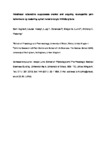Intrathecal reboxetine suppresses evoked and ongoing neuropathic pain behaviours by restoring spinal noradrenergic inhibitory tone.
| dc.contributor.author | Hughes, S | en |
| dc.contributor.author | Hickey, L | en |
| dc.contributor.author | Donaldson, LF | en |
| dc.contributor.author | Lumb, BM | en |
| dc.contributor.author | Pickering, AE | en |
| dc.date.accessioned | 2020-07-29T12:39:37Z | |
| dc.date.available | 2020-07-29T12:39:37Z | |
| dc.date.issued | 2015-02 | en |
| dc.identifier.uri | http://hdl.handle.net/10026.1/16120 | |
| dc.description.abstract |
The descending noradrenergic (NAergic) projection to the spinal cord forms part of an endogenous analgesic system. After nerve injury, a localised failure in this compensatory system has been implicated as a permissive factor in the development of neuropathic sensitisation. We investigated whether restoring descending NAergic tone with intrathecal reboxetine can oppose the development of the neuropathic pain phenotype after tibial nerve transection (TNT). Rats had a lumbar intrathecal catheter implanted at the time of nerve injury for administration of reboxetine (10 μg) in both acute and chronic dosing experiments. In acute dosing experiments, both intrathecal and systemic (30 mg/kg) reboxetine partially reversed mechanical allodynia. This antiallodynic effect of intrathecal reboxetine was blocked by prior administration of yohimbine (α2-adrenoceptor antagonist, 30 μg) but not by prazosin (α1-adrenoceptor antagonist, 30 μg) or propranolol (β-adrenoceptor antagonist, 100 μg). Chronic intrathecal reboxetine (10 μg, intrathecally, twice daily for 2 weeks) suppressed the development of cold and mechanical allodynia. Nerve-injured animals demonstrated a place preference for intrathecal reboxetine, suggesting that it also reduced spontaneous pain. In contrast, an equivalent antiallodynic dose of systemic reboxetine (30 mg/kg) was aversive in both naive and TNT rats. On cessation of chronic intrathecal reboxetine, there was a gradual development of allodynic sensitisation that was indistinguishable from control TNT animals by 7 days after the end of dosing. Our results suggest that pharmacological restoration of spinal NAergic tone with intrathecal reboxetine can suppress both allodynia and spontaneous pain in the TNT model. | en |
| dc.format.extent | 328 - 334 | en |
| dc.language | eng | en |
| dc.language.iso | eng | en |
| dc.subject | Adrenergic Neurons | en |
| dc.subject | Adrenergic Uptake Inhibitors | en |
| dc.subject | Animals | en |
| dc.subject | Injections, Spinal | en |
| dc.subject | Male | en |
| dc.subject | Morpholines | en |
| dc.subject | Neural Inhibition | en |
| dc.subject | Neuralgia | en |
| dc.subject | Norepinephrine | en |
| dc.subject | Rats | en |
| dc.subject | Rats, Wistar | en |
| dc.subject | Reboxetine | en |
| dc.title | Intrathecal reboxetine suppresses evoked and ongoing neuropathic pain behaviours by restoring spinal noradrenergic inhibitory tone. | en |
| dc.type | Journal Article | |
| plymouth.author-url | https://www.ncbi.nlm.nih.gov/pubmed/25599454 | en |
| plymouth.issue | 2 | en |
| plymouth.volume | 156 | en |
| plymouth.publication-status | Published | en |
| plymouth.journal | Pain | en |
| dc.identifier.doi | 10.1097/01.j.pain.0000460313.73358.31 | en |
| plymouth.organisational-group | /Plymouth | |
| plymouth.organisational-group | /Plymouth/Faculty of Health | |
| plymouth.organisational-group | /Plymouth/Faculty of Health/School of Psychology | |
| plymouth.organisational-group | /Plymouth/REF 2021 Researchers by UoA | |
| plymouth.organisational-group | /Plymouth/REF 2021 Researchers by UoA/UoA04 Psychology, Psychiatry and Neuroscience | |
| plymouth.organisational-group | /Plymouth/REF 2021 Researchers by UoA/UoA04 Psychology, Psychiatry and Neuroscience/UoA04 Psychology, Psychiatry and Neuroscience MANUAL | |
| plymouth.organisational-group | /Plymouth/Users by role | |
| plymouth.organisational-group | /Plymouth/Users by role/Academics | |
| dc.publisher.place | United States | en |
| dc.identifier.eissn | 1872-6623 | en |
| dc.rights.embargoperiod | Not known | en |
| rioxxterms.versionofrecord | 10.1097/01.j.pain.0000460313.73358.31 | en |
| rioxxterms.licenseref.uri | http://www.rioxx.net/licenses/all-rights-reserved | en |
| rioxxterms.type | Journal Article/Review | en |


